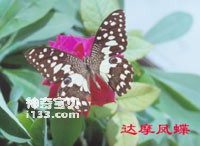Butterflies give people a sense of beauty with their gorgeous patterns, colorful colors and moving dancing postures. In addition to appearing in artistic works such as oil paintings, coins, stamps, photography, textiles, and literary works such as poetry, their specimens are also used to make various handicrafts. Put the whole butterfly specimen in a transparent container, such as a glass (plexiglass) plate, arrange it into various ecological shapes, add flowers, plants and leaves, and seal it to become a variety of handicrafts. Some also embed butterflies in transparent amber and other media to make handicrafts, or press films to make various New Year cards, head flowers, earrings and other handicrafts. The Bodhidharma swallowtail butterfly is the best butterfly to watch.

The wingspan is 80-95 mm, the sides of the body are yellowish white, and the back of the body is black or dark brown. The wings are black or brown-black, and the markings on the fore and hind wings are yellow-white or brown except for the middle spot on the front edge of the hind wing and the buttock spot, which are different in color. There are many fine horizontal stripes composed of many fine yellow spots on the base and subunit areas of the forewings. There are spots on the outer edge and sub-outer edge. There are many irregularly arranged spots of different sizes in the middle and middle rear areas. The subtop is There is a long spot on the horn, the outer edge is wavy, and there are yellow spots in the trough. There are rows of spots on the outer edge and sub-outer edge of the hind wings, and the large spots in the middle front area and subbasal area are connected to form a wide transverse band with an arc-shaped inner side and uneven outer sides; the middle spot on the front edge has a blue pupil spot, and the rump angle is It has erythema, the outer edge is wavy, and there are yellow spots in the trough. The reverse side of the front wing is roughly similar to the front wing except that there are radial stripes at the base and 3 to 4 yellow-brown spots on the inner side of the sub-apical corner. There are 3 more light yellow spots at the base of the hind wings; the middle area has an apricot yellow spot, which is larger and clearer than other spots; the arrangement of other spots is roughly similar to that on the front.
Oval, yellow, with yellowish-brown stains when hatching. Diameter is about 1.1mm.
The 1st to 4th instar larvae are guano-like: the head is brown with light brown cloud-like spots; the body background is black, with white lines on the chest and the sides of abdominal segments 7 to 9; the sides and back of abdominal segments 2 to 5 Form a "V" shaped leucorrhea. Mature larvae are green. There is a yellow-brown horizontal band on the anterior edge of the metathorax and the posterior edge of the first abdominal segment. The 3rd and 4th abdominal segments have a pair of brown diagonal bands with mottled purple and white fine lines in the bands; the 5th abdominal segment has 1 small brown spot and 2 purple dots on the subdorsal surface, and the 6th abdominal segment has 1 small brown spot on the subdorsal surface. There is 1 purple dot. The valve is brown, the base of the horn is orange-yellow, and the tip is orange-red.
The body color of the pupa varies between green and brown depending on the environment. There is a pair of short protrusions on the top of the head and in the center of the middle chest. The abdomen protrudes slightly to both sides. There is a small tumor on each side of the subdorsal side of the 4th to 7th abdominal segments. Body length is about 34mm.
Host: Clausena lansium, C. excavata, Cornus officinale, Zanthoxylum bungeanum and other plants of the Rutaceae family.
Biology: Multiple generations occur in a year, overwintering as pupae. Adults occur from April to October in the northern region, and appear year-round in the southern region. The adults fly quickly, love to visit flowers, like moisture, and often move around waterside and ponds. The egg stage lasts for 3 to 6 days, the larval stage lasts for 14 to 21 days, and the pupa stage lasts for about 14 days. The female lays eggs alone on the young leaves and terminal buds of the host plant. The larvae often move on the shady side of the host plant. The mature larvae pupate on the host plant and in nearby dark places.
Distribution: Hubei, Jiangxi, Zhejiang, Yunnan, Guizhou, Sichuan, Hainan, Guangdong, Guangxi, Fujian, Taiwan; Sikkim, India, Bhutan, Nepal, Sri Lanka, Myanmar, Thailand, Malaysia, Australia, New Guinea.
animal tags:
We created this article in conjunction with AI technology, then made sure it was fact-checked and edited by a Animals Top editor.